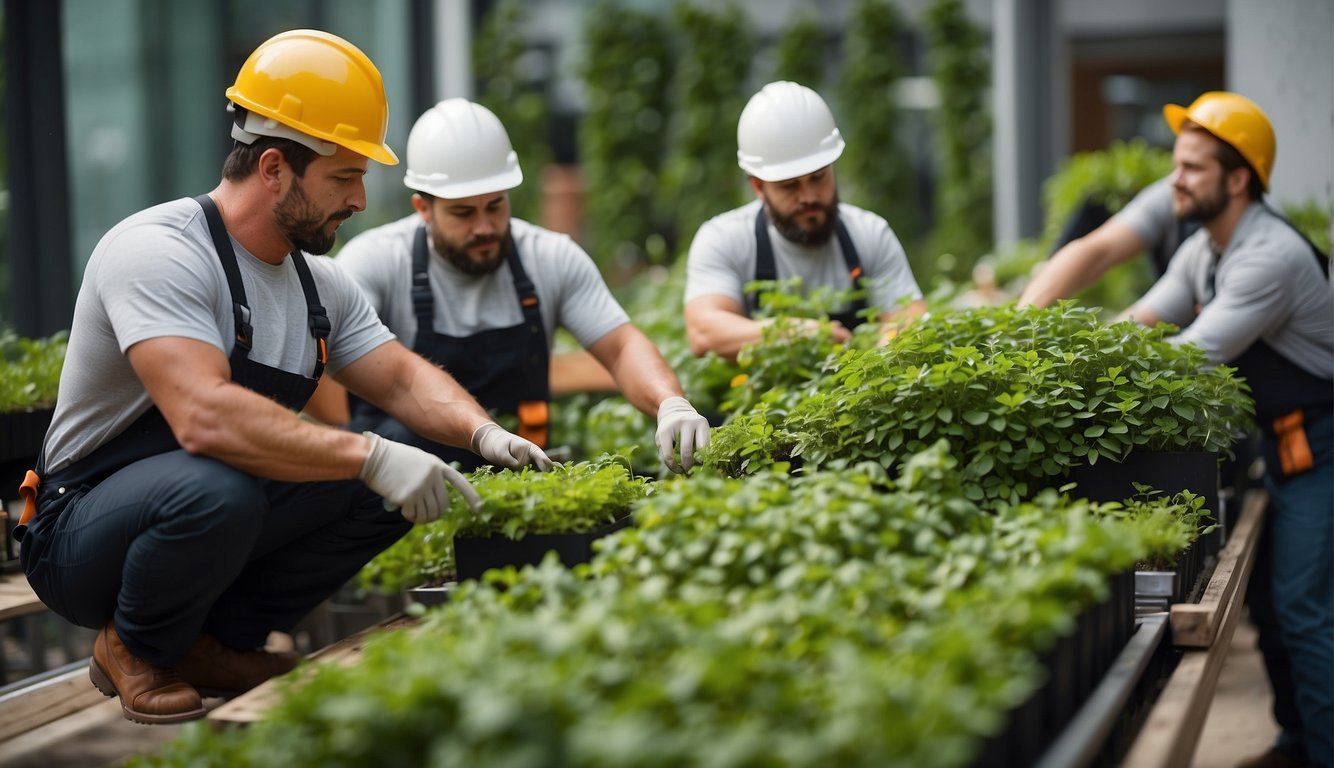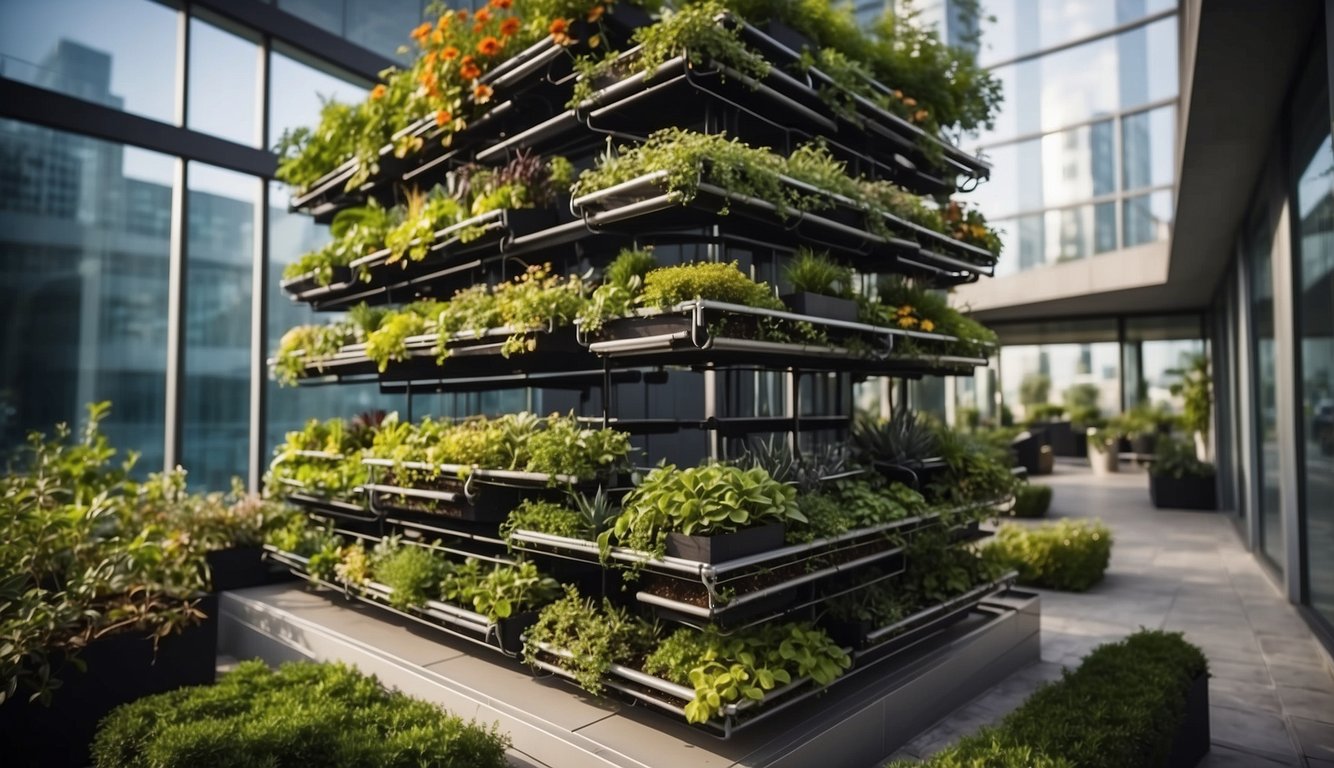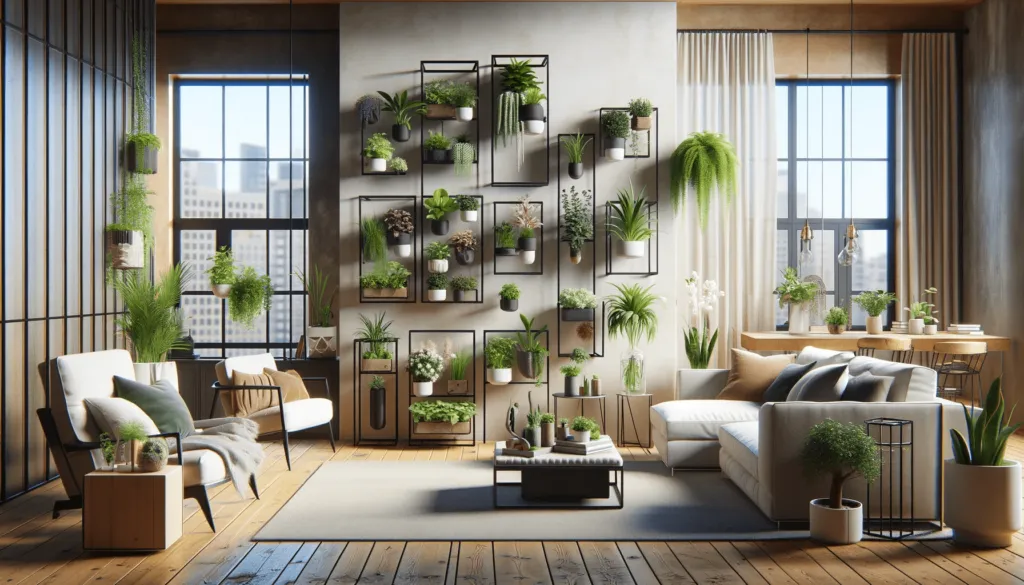Vertical gardens are a popular choice for those who want to add greenery to their homes without taking up too much space. Not only do they provide a stunning aesthetic, but they also offer numerous environmental benefits. However, before you start planting, it’s crucial to plan the structure of your vertical garden to ensure its success. In this article, we’ll take a look at the key factors to consider when planning the structural design of your vertical garden.

When planning your vertical garden, it’s essential to consider the available space and the structure that will best fit in with your existing landscape. There are various types of structures to choose from, including fences, arbors, trellises, tuteurs, and obelisks. You can also opt for living walls, which are becoming increasingly popular in both residential and commercial settings. By selecting the right structure, you can create a beautiful and functional vertical garden that complements your home’s architecture while providing a stunning visual display.
Table of Contents
Key Takeaways
- Careful planning is essential for the success of your vertical garden.
- Choosing the right structure is crucial to ensure that your vertical garden complements your home’s architecture and existing landscape.
- Living walls are becoming increasingly popular and offer a stunning visual display while providing numerous environmental benefits.
Planning Your Vertical Garden

When planning your vertical garden, it is important to consider several factors to ensure a successful and thriving garden. We recommend following a step-by-step guide to help you plan and build your vertical garden.
Plan
The first step is to plan your garden. Consider the available space and the goals you want to achieve. Determine what plants you want to grow and how much sunlight they need. Decide on the type of structure you want to build or purchase, such as a trellis, wall planter, or hanging baskets.
Location
The location of your vertical garden is crucial to its success. Choose a spot that receives the right amount of sunlight for the plants you want to grow. Ensure that the location is easily accessible for watering and maintenance.
Sunlight
Different plants require different amounts of sunlight. When planning your vertical garden, consider the amount of sunlight the location receives throughout the day. Some plants thrive in full sun, while others prefer partial shade. Make sure to choose plants that are suitable for the amount of sunlight in your chosen location.
Design Considerations
Design considerations are important in creating an aesthetically pleasing vertical garden. Consider the colors and textures of the plants you choose, as well as the materials and colors of the structure you build. Use a mix of trailing plants, upright plants, and flowering plants to create depth and interest.
Building a Vertical Garden
Building a vertical garden can be done in several ways. You can purchase a pre-made structure or build your own. If you decide to build your own, consider the materials you will use, such as wood, metal, or PVC. Ensure that the structure is sturdy and can support the weight of the plants.
Step-by-Step Guide
Following a step-by-step guide can help you plan and build your vertical garden. Start by planning your garden and choosing the location. Determine the amount of sunlight the location receives and choose plants that are suitable for the amount of sunlight. Consider design considerations and build or purchase a structure. Finally, plant your garden and enjoy the beauty and benefits of your new vertical garden.
By following these steps, you can create a beautiful and thriving vertical garden that will enhance the beauty of your space and provide numerous benefits.
Choosing Plants and Structures

When it comes to vertical garden structural planning, selecting the right plants and structures is crucial. In this section, we will discuss the two main considerations when choosing plants and structures: selecting plant species and structural considerations.
Selecting Plant Species
When selecting plant species for a vertical garden, it is important to choose plants that are suitable for vertical growth. Climbing plants are an obvious first choice, but there are also many other plant species that work well in vertical gardens. Some popular options include ferns, succulents, and herbs.
When selecting plant species, it is also important to consider the environment in which the vertical garden will be located. For example, if the garden will be located in a sunny area, it is important to choose plants that thrive in full sun. Similarly, if the garden will be located in a shady area, it is important to choose plants that can tolerate low light conditions.
Structural Considerations
Structural considerations are also an important consideration when planning a vertical garden. There are many different types of structures that can be used to support a vertical garden, including trellises, fences, planters, green walls, and living walls.
When choosing a structure, it is important to consider the weight of the plants and the structure itself. For example, if the plants are heavy, a sturdy trellis or fence may be required. Similarly, if the structure will be attached to a wall, it is important to ensure that the wall can support the weight of the structure and the plants.
It is also important to consider the materials that will be used to construct the structure. For example, wood is a popular choice for trellises and fences, while metal is often used for green walls and living walls. The choice of materials will depend on factors such as the environment, the desired aesthetic, and the budget.
In conclusion, selecting the right plants and structures is crucial when planning a vertical garden. By considering factors such as plant species and structural considerations, we can create a beautiful and functional vertical garden that will thrive for years to come.
Installation and Maintenance

At this point, we have selected the right materials, built a sturdy support structure, and chosen the right plants for our vertical garden. Now, we need to focus on installing the irrigation systems and performing ongoing care and maintenance to ensure our garden thrives.
Setting Up Irrigation Systems
Proper irrigation is crucial to the success of our vertical garden. We recommend installing a drip irrigation system that delivers water directly to the base of each plant. This will help prevent water waste and ensure the plants receive the right amount of water.
To set up the irrigation system, we will need to connect the main water supply to a timer, which will control how often and how long the water is delivered to the garden. From there, we will run tubing from the timer to each row of plants and install drip emitters at the base of each plant.
Ongoing Care and Maintenance
Once our vertical garden is installed and the irrigation system is set up, we need to focus on ongoing care and maintenance. This includes training, pruning, fertilizing, and water management.
Training involves guiding the plants to grow in the desired direction. For example, we may need to attach vines to a trellis or tie branches to a support structure. Pruning involves cutting back overgrown or damaged branches to promote healthy growth.
Fertilizing is important for providing the plants with the nutrients they need to thrive. We recommend using a slow-release fertilizer that is designed for use in container gardens.
Water management is also crucial to the success of our vertical garden. We need to monitor the soil moisture levels regularly and adjust the irrigation system as needed to ensure the plants are receiving the right amount of water.
By following these tips for installation and ongoing care and maintenance, we can ensure our vertical garden thrives and provides us with a beautiful and bountiful harvest.
Design and Aesthetics
When it comes to designing a vertical garden, we need to balance both aesthetics and functionality. A well-designed vertical garden should not only look beautiful but also serve its purpose of creating a green area and improving air quality.
One design tip is to use a variety of plants to create a visually appealing and diverse garden. We can use climbing vines, hanging baskets, wall pockets, or even picture frames to create a unique and eye-catching design. By using different textures, colors, and shapes, we can create a dynamic and interesting living wall.
In addition to aesthetics, sustainability should also be a key consideration in our design. We can use recycled materials for the structure of the garden, such as repurposed wood or metal. We can also choose plants that are native to the area, which require less water and maintenance.
Another important aspect of a vertical garden is ensuring that it is easy to maintain. We can design the garden with easy-to-reach planters and irrigation systems, which will make it easier to water and care for the plants.
Overall, designing a vertical garden requires careful consideration of both aesthetics and functionality. By incorporating design tips, sustainability, and easy maintenance, we can create a beautiful and functional living wall that improves the air quality and adds a green area to any space.
Benefits of Vertical Gardens

Vertical gardens offer numerous benefits that make them an excellent choice for urban spaces. Here are some of the benefits of vertical gardens:
Biodiversity
Vertical gardens can provide habitat for a variety of plant and animal species, increasing biodiversity in urban areas. By incorporating a variety of plants with different textures, colors, and growth patterns, vertical gardens can attract pollinators such as bees and butterflies, which are essential for plant reproduction.
Air Quality
Vertical gardens can improve air quality by absorbing pollutants such as carbon dioxide, ozone, and particulate matter. Plants release oxygen during photosynthesis, which can help to reduce air pollution and improve air quality.
Energy Consumption
Vertical gardens can help to reduce energy consumption by providing shade and insulation. By shading buildings and outdoor spaces, vertical gardens can help to reduce the amount of energy needed for cooling, which can help to lower energy bills and reduce greenhouse gas emissions.
Cooling
Vertical gardens can help to cool urban areas by reducing the amount of heat absorbed by buildings and outdoor spaces. Plants absorb sunlight and release water vapor through transpiration, which can help to lower temperatures in urban areas and reduce the urban heat island effect.
Air Purification
Vertical gardens can help to purify the air by absorbing pollutants and releasing oxygen. Plants can remove harmful chemicals such as benzene, formaldehyde, and trichloroethylene from the air, which can help to improve indoor air quality and reduce the risk of respiratory problems.
Sustainability
Vertical gardens are a sustainable way to grow plants in urban areas. They can be designed to use recycled materials, rainwater harvesting systems, and renewable energy sources such as solar panels. Vertical gardens can also help to reduce the amount of waste produced by urban areas by composting organic waste and using it to fertilize plants.
Climate
Vertical gardens can help to mitigate the effects of climate change by reducing greenhouse gas emissions and increasing carbon sequestration. Plants absorb carbon dioxide during photosynthesis, which can help to reduce the amount of carbon dioxide in the atmosphere and slow the rate of climate change.
Conclusion

In conclusion, vertical gardens offer a sustainable solution to modern design, addressing environmental concerns while enhancing the well-being of individuals. By integrating vertical gardens into sustainable design, we can purify the air, reduce noise, improve energy efficiency, and increase property value.
We have seen numerous case studies where vertical gardens have been successfully implemented, such as the famous Hanging Gardens of Babylon and the work of Patrick Blanc. These examples demonstrate the potential of vertical gardens to transform urban spaces and bring nature back into our cities.
When planning the structural design of a vertical garden, it is important to consider factors such as the weight of the plants, the type of irrigation system, and the amount of sunlight the garden will receive. By carefully considering these factors, we can ensure that our vertical gardens are not only beautiful but also functional and sustainable.
In summary, we believe that vertical gardens have a vital role to play in the future of urban gardening. By incorporating them into our cities and buildings, we can create healthier, more sustainable environments for ourselves and for future generations.
Frequently Asked Questions
What are the essential components required for constructing a vertical garden?
Constructing a vertical garden requires careful planning and attention to detail. The essential components required for constructing a vertical garden include a support structure, water-resistant backing, and a growing medium. The support structure can be made of wood, metal, or plastic, and it should be sturdy enough to support the weight of the plants and the growing medium. The water-resistant backing is necessary to protect the wall from water damage, and it can be made of materials such as waterproof membranes, plastic sheets, or metal panels. The growing medium should be lightweight and well-draining, such as a soilless mix or a hydroponic substrate.
How should one calculate the load-bearing capacity for a wall-mounted vertical garden?
Calculating the load-bearing capacity for a wall-mounted vertical garden requires a thorough understanding of the wall’s construction and load-bearing capacity. We recommend consulting with a structural engineer or a licensed contractor to determine the wall’s load-bearing capacity. Factors that can affect the load-bearing capacity include the wall’s thickness, the type of construction materials used, and the age and condition of the wall.
What are the best practices for waterproofing in vertical garden installations?
Waterproofing is a critical component of vertical garden installations, as it helps to prevent water damage to the wall and surrounding structures. The best practices for waterproofing in vertical garden installations include using high-quality waterproofing materials, such as waterproof membranes or coatings, and ensuring that the waterproofing extends beyond the edges of the vertical garden. It is also important to seal any gaps or seams in the waterproofing material to prevent water from seeping through.
Which materials are most suitable for framing outdoor vertical gardens to ensure longevity?
Choosing the right materials for framing outdoor vertical gardens is crucial to ensure longevity and durability. We recommend using materials that are resistant to weathering and corrosion, such as treated wood, galvanized metal, or PVC. These materials can withstand exposure to moisture, sunlight, and other environmental factors, which can help to prolong the life of the vertical garden.
How can one optimize plant spacing in a vertical garden for adequate growth and maintenance?
Optimizing plant spacing in a vertical garden is essential for ensuring adequate growth and maintenance. We recommend spacing plants according to their mature size and growth habits, and considering factors such as light requirements and water needs. It is also important to leave enough space between plants to allow for air circulation and prevent overcrowding, which can lead to disease and pest problems.
What irrigation systems are recommended for efficient water management in vertical gardens?
Efficient water management is critical for the success of vertical gardens, and irrigation systems can help to ensure that plants receive the right amount of water at the right time. We recommend using drip irrigation systems, which deliver water directly to the roots of the plants and reduce water loss through evaporation. It is also important to monitor soil moisture levels regularly and adjust watering schedules as needed to avoid over- or under-watering.


